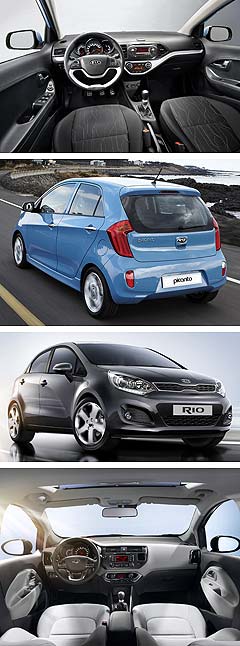Geneva show: Kia Oz goes gunning for Picanto
BY RON HAMMERTON | 1st Mar 2011

If the Australian business case for the cheeky European-styled, Korean-built Picanto hatchback is accepted by head office, it will join a rush of new models arriving in Australia from the fast-growing company over the next two years, including an all-new Cerato small car, a replacement for the top selling but ageing Carnival and a fresh Soul.
The second-generation Picanto, which along with the new Rio was unveiled in the flesh last night in Switzerland at a Kia event on the eve of the Geneva motor show, would be pitched at entry level newcomers such as the Suzuki Alto, Holden Barina Spark and Nissan Micra.
It would not be expected to arrive in Australia until 2012, the same year that Kia will launch a new Cerato small car built on an all-new platform being developed with partner Hyundai.
The bid for a local launch of Picanto was confirmed by KMAu national public relations manager Kevin Hepworth, who said the Australian subsidiary was awaiting a response from Seoul.
He said the previous Picanto had been rejected for Australia as KMAu felt that the market was not ready for such small cars when it was launched in Europe and South Korea in 2004.

“No one wants to be the first to jump in the pool, especially when the pool is that small,” he said.
Mr Hepworth said that, while the market for such vehicles was still small, it had potential to grow.
As the Picanto is already made in right-hand drive for the UK, it would seem relatively easy to tick the production box for Australian shipments.
The move could put it on a collision course at the bottom end of the market with sister company Hyundai, which is also considering importing its diminutive Indian-built i10 to slide under the i20.
Kia says its new hatchback Picanto – available in three- and five-door models in Europe from the second quarter of this year – is “all grown up”, with thoroughly modern styling from former Audi designer Peter Schreyer, who has overseen a major overhaul of Kia’s design language over the past four years.
Mr Schreyer was on hand last night to see his new babies unveiled, with Picanto and Rio both emerging from under satin cloths more substantial in almost every way than the previous models.
The Rio – the more conservative of the two designs but still sharp in the new Kia family style – has already been confirmed for an Australian launch about September in the five-door hatch guise that was revealed in Geneva. It will be armed with an 81kW 1.6-litre four-cylinder petrol engine mated with a choice of six-speed manual or automatic transmissions.
Also confirmed for Australia is a Rio sedan that is set to join the range late in the year, followed by a three-door hatch early in 2012.
Pricing is yet to be decided, but a $15,500 starting price for the base five-door Rio seems to be the target, with an automatic version starting from about $17,000.
Rio, built on the same architecture as the Hyundai i20, is 20mm longer, 25mm wider, and 15mm lower than the current car and features a wheelbase extended by 70mm (to 2570 mm), which Kia says greatly enhances passenger space and cargo capacity.
It will be available in Europe with a choice of four engines in three and four cylinders, in petrol and diesel, with power ranging from 51kW to 80kW.
But Australia will miss out on the extremely efficient smaller engines that, with an extra-cost package of fuel efficiency measures such as idle-stop, can achieve a class-best CO2 rating of just 85 grams per kilometre and fuel consumption as low as 3.2 litres per 100km.
Some of these Rio engines will be shared with Picanto in Europe, although larger petrol power – probably the range-topping Kappa 1240cc four-cylinder that generates 63kW and 121Nm of torque – is expected to be preferred for Picanto should it make it to Australia.
Picanto transmissions are a five-speed manual and four-speed automatic, helping to give the European five-door model a CO2 rating of between 95 and 105g/km, while fuel economy will range from 4.2 to 5.9L/100km on the combined cycle.
Kia expects the Picanto and Rio to each score five-star safety ratings, with both models getting up to seven airbags.
Like Rio, Picanto is bigger than its predecessor, and at 3600mm long is some 100mm longer than the Suzuki Alto.
And with a wheelbase 15mm longer than the previous Picanto, the more generous proportions have been put to good effect in passenger space, which Kia says has a big-car feel.
With both Picanto and Rio moving up a size, expect the next-generation Cerato to grow on the new platform that is also expected to spawn a Hyundai small car.
The Cerato came to Australia late in its model life, being launched Down Under at its mid-model change in 2009, so it is already due for an overhaul.
But a major reason behind the decision to develop the next model from the ground up is safety, as the current four-star Cerato cannot be upgraded to meet Kia’s own goal of five-star safety on every new model.
With 2011 Rio now out and about, a new generation of Soul is also believed to be rolling off the drawing board, with a concept expected to front at a motor show – possibly New York – this year.
The boxy but funky Soul was the vehicle that started Kia’s style revolution, which will continue unabated with the next Carnival that is due in 2013.
The vehicle – Australia’s number one-selling people-mover – is expected to be based on the KV7 concept that was shown at this year’s Detroit motor show in January.
And if Kia wasn’t busy enough, its acclaimed Sportage compact SUV is also in for a mid-model tweak in 2012.